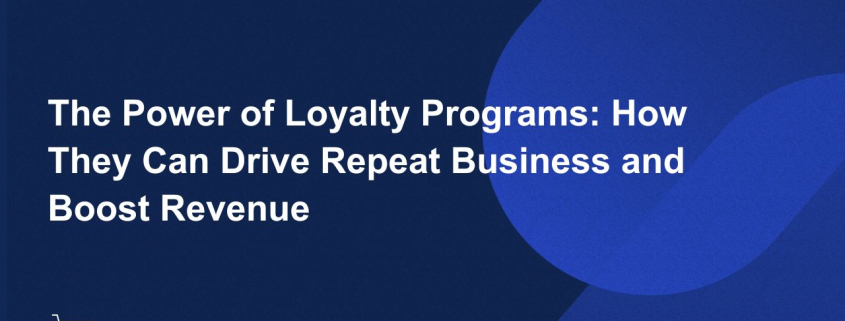The Power of Loyalty Programs: How They Can Drive Repeat Business and Boost Revenue
Introduction
In today’s competitive business landscape, customer loyalty plays a pivotal role in the success of any company. To foster a strong bond with their customers and encourage repeat business, many companies have turned to loyalty programs. These programs are designed to reward customers for their continued patronage and incentivize them to choose a particular brand over its competitors. But what exactly are loyalty programs, and how do they contribute to driving repeat business and boosting revenue? Let’s delve deeper into the world of loyalty programs and explore their remarkable potential.
What Are Loyalty Programs?
Loyalty programs, also known as rewards programs or customer loyalty programs, are structured marketing strategies implemented by businesses to encourage customers to continue purchasing their products or services. These programs aim to cultivate a sense of loyalty and affinity towards a brand by providing exclusive benefits, incentives, and rewards to program members.
The Mechanics of Loyalty Programs
Loyalty programs typically involve the issuance of loyalty cards, points, or digital accounts that track a customer’s purchase behavior. These programs are often tiered, with different levels of rewards corresponding to the customer’s level of engagement or spending. Customers earn points or credits for each transaction and accumulate them over time. They can then redeem these points for discounts, free merchandise, special offers, or other perks offered by the company.
Benefits of Loyalty Programs
Loyalty programs offer numerous advantages for both businesses and customers. Let’s take a closer look at some of the key benefits:
1. Increased Customer Retention
One of the primary goals of loyalty programs is to enhance customer retention. By offering rewards and incentives, companies encourage customers to stay loyal and continue making purchases. According to studies, loyal customers are more likely to stick with a brand they trust rather than switch to competitors, even if they are offered lower prices elsewhere.
2. Repeat Business
Loyalty programs provide a strong incentive for customers to choose a particular brand for their future purchases. By rewarding customers for their loyalty, companies create a sense of goodwill and reciprocity, making customers more likely to return to make additional purchases. This repeat business contributes to a steady revenue stream and helps build a loyal customer base.
3. Customer Engagement and Satisfaction
Implementing a loyalty program fosters a deeper level of engagement between customers and businesses. By actively participating in the program, customers feel valued and appreciated, which enhances their overall satisfaction. The sense of exclusivity and personalized rewards often leads to increased customer loyalty and positive brand perception.
4. Data Collection and Consumer Insights
Loyalty programs provide businesses with a wealth of data and consumer insights. By tracking customers’ purchasing behavior and preferences, companies gain valuable information about their target audience. This data can then be used to tailor marketing campaigns, improve products or services, and deliver personalized offers, further strengthening the customer-brand relationship.
5. Competitive Advantage
In today’s crowded marketplace, loyalty programs can give businesses a competitive edge. By offering unique rewards and benefits, companies differentiate themselves from their competitors and attract more customers. A well-designed loyalty program can become a powerful marketing tool, enhancing brand awareness and positioning in the market.
Best Practices for Loyalty Programs
To ensure the success of a loyalty program, businesses should consider implementing the following best practices:
1. Simplicity and Ease of Use
A loyalty program should be straightforward and easy for customers to understand and participate in. Complex rules or confusing redemption processes can deter customers from engaging with the program. Keeping it simple ensures maximum participation and minimizes friction.
2. Personalization
Tailoring rewards and offers to individual customers’ preferences and purchasing behavior creates a more personalized experience. By leveraging data collected through the loyalty program, businesses can deliver targeted rewards and recommendations, enhancing customer satisfaction and loyalty.
3. Regular Communication
Maintaining regular communication with loyalty program members is crucial. Sending personalized emails, notifications, or updates about new offers, rewards, or program enhancements keeps customers engaged and reminds them of the benefits they can enjoy. It also provides an opportunity to gather feedback and address any concerns.
4. Gamification Elements
Introducing gamification elements, such as progress bars, badges, or challenges, can make the loyalty program more interactive and enjoyable for customers. These elements add an element of fun and competition, motivating customers to participate actively and earn more rewards.
Examples of loyalty programs in different industries
There are numerous niches in ecommerce, and each niche can benefit from a well-designed loyalty program. Here are a few examples of niches in ecommerce along with suitable loyalty program ideas:
1. Fashion and Apparel:
- Points-Based Loyalty Program: Customers earn points for every purchase, which they can redeem for discounts or exclusive merchandise.
- Tiered Loyalty Program: Customers can unlock higher tiers by reaching certain spending thresholds, gaining access to premium benefits like early access to sales or personalized styling consultations.
2. Beauty and Cosmetics:
- Referral Program: Customers receive rewards or discounts for referring friends or family to make a purchase.
- Subscription-Based Loyalty Program: Customers who subscribe to monthly beauty boxes or auto-replenishment programs receive special perks, such as free samples or early product releases.
3. Health and Wellness:
- Wellness Challenges: Customers earn rewards or discounts for achieving specific wellness goals, such as completing a certain number of workouts or tracking their nutrition.
- VIP Access: Customers who regularly purchase health and wellness products can gain VIP status, granting them exclusive access to expert content, online seminars, or personalized health consultations.
4. Home Decor and Furnishings:
- Exclusive Events: Loyalty program members are invited to exclusive in-store or virtual events where they can preview new collections, attend workshops, or receive personalized interior design consultations.
- Tiered Discounts: Customers in higher tiers receive increasing discounts based on their loyalty and spending history, encouraging repeat purchases and larger orders.
5. Electronics and Gadgets:
- Early Access to Product Releases: Loyalty program members have the opportunity to purchase new electronics and gadgets before they are available to the general public.
- Trade-In Program: Customers can trade in their old devices for credits or discounts on new purchases, incentivizing them to upgrade their gadgets while fostering brand loyalty.
6. Pet Supplies:
- Frequent Shopper Program: Customers who make a certain number of purchases within a specified period receive a free pet product or a discount on their next purchase.
- Personalized Recommendations: Loyalty program members receive tailored product recommendations based on their pet’s breed, age, or preferences, enhancing their shopping experience.
Remember, when designing a loyalty program, it’s important to consider the specific needs and preferences of your target audience in each niche. Tailor the rewards and benefits to align with their interests, and regularly evaluate and optimize the program based on customer feedback and data analysis.
The Future of Loyalty Programs
As technology continues to advance, loyalty programs are evolving to meet the changing needs and preferences of customers. Mobile apps, digital wallets, and personalized experiences are becoming more prevalent in loyalty programs, providing a seamless and convenient way for customers to engage with their favourite brands.
Furthermore, loyalty programs are expanding beyond traditional retail sectors. Industries such as hospitality, travel, and financial services are also embracing loyalty programs to enhance customer loyalty and drive repeat business.
Conclusion
Loyalty programs hold immense power in driving repeat business and boosting revenue for businesses across various industries. By fostering customer loyalty, encouraging repeat purchases, and providing personalized rewards, these programs create a win-win scenario for both businesses and customers. As the business landscape continues to evolve, loyalty programs will remain a crucial tool in building strong customer relationships and gaining a competitive edge.
So, if you haven’t already, consider implementing a loyalty program for your business and unlock the remarkable potential it holds. Your customers will appreciate the rewards, and you’ll reap the benefits of their continued loyalty.



